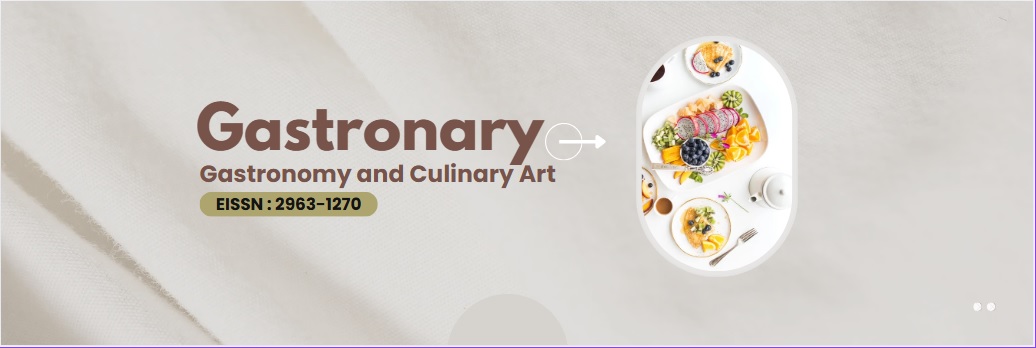Wet Spring Rolls Innovation with Banana Kepok Peel
DOI:
https://doi.org/10.36276/gtr.v1i1.377Keywords:
Pisang Kepok, Lumpia, Organoleptic test, wet springs rollAbstract
Kepok banana (Musa Paradisiaca Linn) is a type of fruit plant that can be harvested from all tree parts. Researchers reinvented wet spring rolls in this experiment by substituting kepok banana peels for the main filling, bamboo shoots. This study aims to determine the preference and acceptability of wet spring rolls with kepok banana peel filling compared to bamboo shoots in terms of taste, flavour, colour, and texture. This study employs the descriptive quantitative method, organoleptic testing and the difference test. This study was conducted on the STP AMPTA Yogyakarta campus using a purposive sampling technique with up to 15 panellists. The author used literature studies, questionnaires, and documentation to collect data. According to the results of the organoleptic test, 73.3% of the panellists said they liked the taste. Regarding flavour, 53.3% of the panellists said they liked it. Regarding colour, 60% of the panellists said they liked it. Sixty per cent of the panellists said they liked the texture. The average value of the four aspects in the different tests is more significant than number six. This research suggests that wet spring rolls with kepok banana peels are just as good as wet spring rolls with bamboo shoots. Wet spring rolls with banana peel stuffing have a taste value of 6,53, while bamboo shoots stuffed to have a value of 6,87. Wet spring rolls with banana peel stuffing have an average flavour value of 6,53, while bamboo shoots stuffed have an average flavour value of 6,87. Regarding colour, wet spring rolls with banana peel stuffing have an average value of 6,13, while bamboo shoots stuffed have an average value of 6,53. Wet spring rolls with banana peel stuffing have an average texture value of 6,47, while bamboo shoots stuffed have an average texture value of 6,20.
References
Afriandi, Lahming, Subari, Y. (2018).Pemanfaatan Limbah Kulit Pisang Kepok (Musa Paradisiaca Linn)Dengan Variasi Buah Naga Menjadi Permen Fungsional.Jurnal Pendidikan Teknologi Pertanian, 15, 124. Tersedia file:///C:/Users/user/Downloads/6225-14713-1-SM.pdf
Anwar, H., Septiani, Nurhayati. (2021).Pemanfaatan Kulit Pisang Kepok (Musa Paradisiaca Linn) Sebagai Substitusi Tepung Terigu Dalam Pengolahan Biskuit.SELAPARANG Jurnal Pengabdian Masyarakat Berkemajuan, 4(2).319. Tersedia file:///C:/Users/user/Downloads/4377-15260-3-PB.pdf
Djunaedi, E. (2006).Pemanfaatan Limbah Kulit Pisang Sebagai Sumber Pangan Alternatif dalam Pembuatan Cookies. Tersedia https://docplayer.info/71127571-Pemanfaatan-limbah-kulit-pisang-sebagai-sumber-pangan-alternatif-dalam-pembuatan-cookies-edi-djunaedi.html
Hidiarti, O., G., dan Mia S. (2019).Pemanfaatan Tepung Kulit Pisang Kepok (Musa Paradisiaca Linn) Dalam Pembuatan Brownis.Jurnal Ilmiah Kesehatan (JIKA), 1(1), 36. Tersedia https://core.ac.uk/download/pdf/249334838.pdf
http://eprints.umm.ac.id/39524/3/BAB%202.pdf.Diakses tanggal 20 April 2021 (11.16)
http://eprints.poltekkesjogja.ac.id/942/5/5.Chapter2.doc.PDF.Diakses tanggal 20 April 2021 (11.53)
https://repository.usm.ac.id/files/skripsi/D11A/2015/D.131.15.0012/D.131.15.0012-05-BAB-II-20190301125321.pdf.Diakses tanggal 2 Juni 2021 (10.46)
http://blog.sayurbox.com/10-jenis-pisang/.Diakses tanggal 7 Agustus 2021 (22.09)
https://www.piknikdong.com/resep-lumpia-rebung.html.Diakses tanggal 7 Agustus 2021 (22.59)
https://www.yummy.co.id/blog/resep-komunitas/lumpia-basah-isi-ayam-1.Diakses tanggal 7 Agustus 2021 (23.05)
Husnia, W., K. (2014).Khasiat Ajaib Pisang : A to Z Khasiat dari Akar Hingga Kulit Buahnya. Yogyakarta: Rapha Publishing
Julfan, Noviar H., Rahmayuni. (2016).Pemanfaatan Kulit Pisang Kepok (Musa Paradisiaca Linn) Dalam Pembuatan Dodol.Jurnal Online Mahasiswa (JOM) Bidang Pertanian, 3(2), 11. Tersedia https://media.neliti.com/media/publications/202974-pemanfaatan-kulit-pisang-kepok-musa-para.pdf
Muhtar, Yumima, S., Hasna, A. (2017).Pemanfaatan Tumbuhan Bambu Oleh Masyarakat di Kecamatan Oba Utara Kota Tidore Kepulauan. J.Saintifik@MIPA, 1(1), 41. Tersedia http://ejournal.unkhair.ac.id/index.php/Saintifik/article/viewFile/335/255.
Nurwanti, Y., H. (2011).Dinamika Kewirausahaan Kuliner : Lunpia Semarang Tahun 1965-2009.Jurnal Patrawidya seri penerbitan penelitian sejarah dan budaya, 12(2), 234.
Qomari, R. (2009).Teknik Penelusuran Analisis Data Kuantitatif dalam Penelitian Kependidikan.Jurnal Pemikiran Alternatif Kependidikan,INSANIA, 14(3), 2. Tersedia file:///C:/Users/user/Downloads/372-Article%20Text-721-1-10-20150304.pdf
Rustanti Monica Emy.(2018).Potensi Kulit Pisang Kepok Kuning (Musa Paradisiaca L.) Sebagai Bahan Tambahan Dalam Pembuatan Es Krim.Universitas Sanata Dharma Yogyakarta.49.Tersedia https://repository.usd.ac.id/28755/2/141434015_full.pdf.Diakses pada 8 Juli 2021 (15.45)
Santosa. (2018).Statistika Hospitalitas. Yogyakarta: CV Budi Utama
Saskia, R., Usman, P., Rahmayuni. (2017).Pengaruh Konsentrasi Garam Terhadap Kadar HCN dan Penilaian Sensori Pikel Rebung.Jom FAPERTA, 4(1), 2. Tersedia https://media.neliti.com/media/publications/202724-pengaruh-konsentrasi-garam-terhadap-kada.pdf
Sugiyono. (2013).Metodologi Penelitian Kuantitatif, Kualitatif. Dan R&D. Bandung: Alfabeta
Sugiyono. (2016).Metode Penelitian Kualitatif, Kuantitatif, dan R&D. Bandung: Alfabeta
Tim Primarasa Femina Group. (2018).Bisnis Kuliner Kreatif : Lumpia, Pastel, dan Risoles. Jakarta: Gaya Favorit Pre
Downloads
Published
How to Cite
Issue
Section
Categories
License
Copyright (c) 2022 Din Dinar Safira Kamal

This work is licensed under a Creative Commons Attribution-ShareAlike 4.0 International License.






